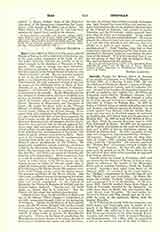

Ibas (Syriac IHIBZ or HlBn, i.e. DONATUS), elected Bishop of Edessa in 439 as successor of Rabbulas, one of the most ardent supporters of St. Cyril; d. 457. His policy, however, was just the reverse, as he inclined strongly to the doctrines of Theodore of Mopsuestia. His reign as bishop was most disturbed. The infuriated partisans of Dioscorus protested and had him deposed at the Second Synod of Ephesus (the “Robber Synod“), in 449. He was, however, restored to his see by the Council of Chalcedon (451). Ibas holds a very important place in the history of dogma. Unfortunately the only authentic writing of his that we possess is his celebrated letter to Maris of Beit-Ardashir (i.e. to Dadisho, Catholicos of Seleucia-Ctesiphon and Patriarch of Persia), a famous subject of discussion at six councils. By the Monophysites he was accused of Nestorianism, nor can it be denied that he was in complete sympathy with the theological school of Antioch, whose masters were Diodorus of Tarsus, Theodore of Mopsuestia, and Theodoret of Cyrus. He taught for many years in the “Persian School” at Edessa, where he had among his pupils several future bishops of the Persian Church; he inspired them with admiration for Theodore of Mopsuestia, and translated for them or had them translate the latter’s works, so that the Syrian Nestorians call the Bishop of Mopsuestia, by antonomasia, the Interpreter. However, Ibas protests that he did not approve Nestorius when that patriarch refused the title of Mother of God to Mary: he only blames the methods adopted by Cyril to procure the condemnation of Nestorius; this much he openly declares in his letter to Maris. Moreover, at the Council of Chalcedon, he anathematized Nestorius both orally and in writing, and was rehabilitated almost unanimously by the Fathers. He indignantly repudiated certain assertions attributed to him by his adversaries, for instance: “I do not envy Christ His becoming God, for I can become God no less than He”, and there is no reason for doubting the sincerity of his protestations. What is certain is, that to avoid all suspicion of Monophysitism, i.e. the confusion, or rather fusion, of the Divine nature and the human nature in Christ, he did not admit what is called the communicatio idiomatum, i.e. the possibility of attributing to the Divine Person the concrete attributes of the human nature, and to the human nature the concrete attributes of the Divine Person. But that is not a sufficient reason for impugning his orthodoxy, as this theory was in his time far from being fully and clearly expounded. At the Council of Chalcedon the Patriarch Maximus of Antioch and the Roman legates declared: “Having read his letter again, we declare that he is orthodox.” But the Fathers did not adopt that opinion unanimously.
A hundred years later, the letter of Ibas to Maris was one of the famous “Three Chapters” condemned at the fifth ecumenical council (553), at the instigation of Justinian. Among the theologians of that council, some, like the Westerns, thought that, as the Council of Chalcedon had rehabilitated Ibas, to condemn his writings would be equivalent to condemning that council, in other words to approve its Monophysite adversaries. Others, in the hope of conciliating the Monophysite partisans known as Severians, thought it necessary to condemn once more, not only Nestorius, but also all writings that inclined towards Nestorianism; they thought the letter of Ibas was impious, because it calumniated St. Cyril, criticized the procedure of the Council of Ephesus, and seemed to justify Nestorius and the Nestorians; others asserted, however, that the letter was apocryphal. In the eighth session (June 2, 553) the council declared: “If anyone defends the aforesaid letter and does not anathematize it, it and him who defends it and who says that it is wholly or at least in part correct let him be anathematized”. Pope Virgilius, who had at first expressed a contrary opinion, and for that reason was attacked by Justinian, ended by sanctioning the decisions of the council. It is to be remarked that it was not the person of Ibas, but only his letter to Maris, that was condemned on this occasion.
JEROME LABOURT

